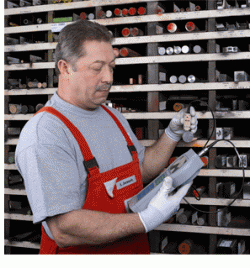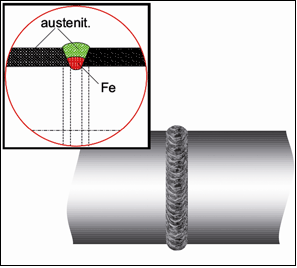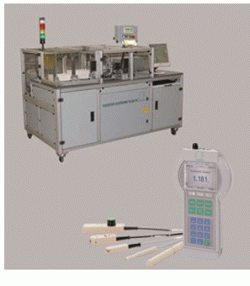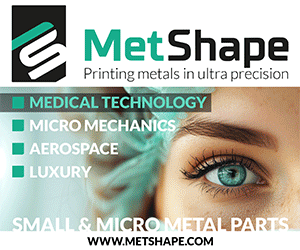Testing sintered products using magnetic characteristic values
September 29, 2010
Institut Dr. Foerster will be presenting its new Koerzimat systems used for the non-destructive testing (NDT) of Powder Metallurgy components at this years PM2010 World Congress in Florence, Italy (October 10-14). Foerster specialise in the testing of variations in magnetic characteristics to measure the quality of sintered components and raw materials.
Friedrich Förster, the founder of Institut Dr. Foerster, recognised the importance of electromagnetic testing methods back in the 1930s, methods that were subsequently backed up by scientific and mathematical findings in the 1950s. Ever since, Foerster has been developing innovative, industry-standard systems based on electromagnetic processes.
The company’s range includes equipment and devices, service and qualified sub-contract measurement, direct from the manufacturer.
As a third-generation, family-run business Foerster designs solutions for its customers’ tasks. The company’s products feature pioneering technology, are innovative and of excellent quality. In continuous co-operation with customers, suppliers and scientists, the company is working to solve the technological challenges of the future. Continuous process optimisation is a prerequisite for perfect products and services.
Coercivity field strength measurement (HcJ measurement) to IEC 60404-7 (EN 10330) with Koerzimat
 Coercivity field strength is a key characteristic of ferromagnetic materials. It is a material-dependent variable that depends greatly on individual proportions in the case of alloys. It is also dependent upon the composition, grain and particle size of non-ferromagnetic elements in the microstructure, the production process, thermal treatment and internal and external mechanical stress. In the field, test specimens of the same material are tested for deviations from their ideal composition. The coercivity field strength is measured independent of geometry.
Coercivity field strength is a key characteristic of ferromagnetic materials. It is a material-dependent variable that depends greatly on individual proportions in the case of alloys. It is also dependent upon the composition, grain and particle size of non-ferromagnetic elements in the microstructure, the production process, thermal treatment and internal and external mechanical stress. In the field, test specimens of the same material are tested for deviations from their ideal composition. The coercivity field strength is measured independent of geometry.
Coercivity field strength measurements are used to monitor manufacturing operations during the production of components with highly permeable materials, such as final annealing, mechanical processing and casting in plastic.
The coercivity field strength measurement is suitable for both solid materials (e.g. sintered metal) and powder (mixtures before the sintering process), allowing quality control of the sintering process.
Moreover, grain growth during the heat treatment of steel can be monitored using the coercivity field strength measurement. The grain size is inversely proportionate to the coercivity field strength. The coercivity field strength measurement is a time-saving and non-destructive method of determining the grain size.
In components that form part of an electromechanical converter, e.g. of solenoid valves in diesel common rail systems, the power that has to be applied for the complete switching process is down to coercivity field strength, among other factors.
Measurement of saturation magnetisation to IEC 60404-14 with Koerzimat.
For the geometry-independent measurement of saturation magnetisation, the magnetic moment is measured using the withdrawal method to IEC 60404-14. This enables both the weight-specific (4πSigma or σs) and volume-specific saturation magnetisation (saturation induction Bs) to be determined.
This in turn permits us to measure the proportion of magnetisable materials in a workpiece, such as the martensite or ferrite proportion of steel, for example.
The process of sintering carbide metal powders can be monitored by determining the proportion taken up by the magnetisable binding agent (cobalt or nickel).
Magnetic permeability measurement with Magnetoscop
 Magnetic permeability reflects the quality of austenitic steel. The magnetic permeability measurement can be used wherever components are intended to have non-magnetic properties. The measurement is employed for checking housing parts of superconductive magnets and components for electron microscopes, and for distinguishing between expensive V4A steel and lower-cost V2A steel.
Magnetic permeability reflects the quality of austenitic steel. The magnetic permeability measurement can be used wherever components are intended to have non-magnetic properties. The measurement is employed for checking housing parts of superconductive magnets and components for electron microscopes, and for distinguishing between expensive V4A steel and lower-cost V2A steel.
Weld seams in austenitic components can also be inspected for deeper ferritic elements by measuring the magnetic permeability.
The Magnetoscop can also be used to verify the presence of outwardly invisible material changes resulting from corrosion, e.g. corrosion on turbine blades provoked by sulphurous fuel.
The Magnetoscop’s easy-to-use probing measurement process will be incorporated in the extension of standards IEC 60404-15 or ASTM A-342M.
More information
Institut Dr. Foerster GmbH & Co. KG ,
Division DM Detection Systems and Magnetics,
In Laisen 70, 72766 Reutlingen,
Germany
Tel: + 49 7121 140-312
Fax + 49 7121 140-280
email: [email protected]


















